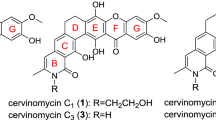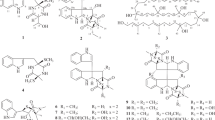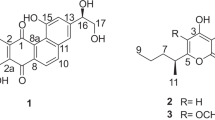Abstract
Two new alkylresorcinols named herein 5’-methoxy-integracins A-B (1-2), two new monomeric alkyl aromatic derivatives 3-(7-hydroxyheptyl)-5-methoxyphenol (5) and 7-(3,5-dihydroxyphenyl) heptyl acetate (6), along with four known compounds including integracins A-B (3-4), 2,4-dihydroxy-6-(8-hydroxyoctyl) benzene (7), and cytosporone B (8) were isolated from the endophytic fungus Cytospora rhizophorae A761. The structures of the four new compounds were elucidated by NMR, HRESIMS data, and electronic circular dichroism (ECD) calculations, whereas the compounds 1 and 2 were disclosed as a class of the natural rare-occurring dimeric alkylresorcinol derivatives. Moreover, the bioassays of the new compounds clarified that compound 1 was a potent inhibitor for the α-glucosidase, and compound 2 showed relatively good activity against the tumor cell lines. It is worth mentioning that the known compound integracin B (4) was first reported to display significant antibacterial activity against Staphylococcus aureus and methicillin-resistant Staphylococcus aureus (MRSA) with MIC values of 6.25 μg ml−1.
This is a preview of subscription content, access via your institution
Access options
Subscribe to this journal
Receive 12 print issues and online access
$259.00 per year
only $21.58 per issue
Buy this article
- Purchase on Springer Link
- Instant access to full article PDF
Prices may be subject to local taxes which are calculated during checkout



Similar content being viewed by others
References
Tian SQ, Sun Y, Chen ZC, Zhao RY. Bioavailability and bioactivity of alkylresorcinols from different cereal products. J Food Qual. 2020;2020:1–6. https://doi.org/10.1155/2020/5781356.
Hammerschick T, Wagner T, Vetter W. Isolation of saturated alkylresorcinols from rye grains by countercurrent chromatography. J Sep Sci. 2021;44:1904–12. https://doi.org/10.1002/jssc.202001230.
Gao YM, Sun TY, Ma M, Chen GD, Zhou ZQ, Wang CX, et al. Adeninealkylresorcinol, the first alkylresorcinol tethered with nucleobase from Lasiodiplodia sp. Fitoterapia. 2016;112:254–9. https://doi.org/10.1016/j.fitote.2016.06.011
Kikuchi H, Ito I, Takahashi K, Ishigaki H, Iizumi K, Kubohara Y. et al. Isolation, synthesis, and biological activity of chlorinated alkylresorcinols from Dictyostelium cellular slime molds. J Nat Prod. 2017;80:2716–22. https://doi.org/10.1021/acs.jnatprod.7b00456.
López-Pliego L, García-Ramírez L, Cruz-Gómez EA, Domínguez-Ojeda P, López-Pastrana A, Fuentes-Ramírez LE. et al. Transcriptional study of the rsmZ-sRNAs and their relationship to the biosynthesis of alginate and alkylresorcinols in Azotobacter vinelandii. Mol Biotechnol. 2018;60:670–80. https://doi.org/10.1007/s12033-018-0102-7.
Luís Â, Domingues F, Duarte AP. Biological properties of plant-derived alkylresorcinols: mini-review. Mini-Rev Med Chem. 2016;16:851–4. https://doi.org/10.2174/1389557516666160211121437.
Kruk J, Aboul-Enein B, Bernstein J, Marchlewicz M. Dietary alkylresorcinols and cancer prevention: a systematic review. Eur Food Res Technol. 2017;243:1693–710. https://doi.org/10.1007/s00217-017-2890-6.
Chen JP, Zhu LJ, Su XX, Zhang KX, Zhang X, Wang JH. et al. New alkylresorcinols from the fruits of Embelia ribes. Fitoterapia. 2018;128:66–72. https://doi.org/10.1016/j.fitote.2018.04.022.
Oskarsson A, Andersson ÅO. Suppressed sex hormone biosynthesis by alkylresorcinols: a possible link to chemoprevention. Nutr Cancer. 2016;68:978–87. https://doi.org/10.1080/01635581.2016.1190022.
Giambanelli E, Ferioli F, D’Antuono LP. Retention of alkylresorcinols, antioxidant activity and fatty acids following traditional hulled wheat processing. J Cereal Sci. 2018;79:98–105. https://doi.org/10.1016/j.jcs.2017.10.010.
Martins TP, Rouger C, Glasser NR, Freitas S, Fraissinette NBDE, Balskus EP. et al. Chemistry, bioactivity and biosynthesis of cyanobacterial alkylresorcinols. Nat Prod Rep. 2019;36:1437–61. https://doi.org/10.1039/c8np00080h.
Kozubek A, Tyman JHP. Resorcinolic lipids, the natural non-isoprenoid phenolic amphiphiles and their biological activity. Chem Rev. 1999;99:1–25. https://doi.org/10.1021/cr970464o.
Ross AB, Kamal-Eldin A, Aman P. Dietary alkylresorcinols: absorption, bioactivities, and possible use as biomarkers of whole grain wheat- and rye-rich foods. Nutr Rev. 2004;62:81–95. https://doi.org/10.1111/j.1753-4887.2004.tb00029.x.
Choi BK, Phan THT, Hwang S, Oh DC, Kang JS, Lee HS. et al. Resorcinosides A and B, glycosylated alkylresorcinols from a marine-derived strain of the fungus Penicillium janthinellum. J Nat Prod. 2019;82:3186–90. https://doi.org/10.1021/acs.jnatprod.9b00776.
Arisawa M, Ohmura K, Kobayashi A, Morita N. A cytotoxic constituent of lysimachia japonica THUNB. (Primulaceae) and the structure-activity relationships of related compounds. Chem Pharm Bull. 1989;37:2431–4. https://doi.org/10.1248/cpb.37.2431.
Jin WT, Zjawiony JK. 5-Alkylresorcinols from Merulius incarnatus. J Nat Prod. 2006;69:704–6. https://doi.org/10.1021/np050520d.
Parikka K, Rowland IR, Welch RW, Wähälä K. In vitro antioxidant activity and antigenotoxicity of 5-n-alkylresorcinols. J Agric Food Chem. 2006;54:1646–50. https://doi.org/10.1021/jf052486e.
Singh SB, Zink DL, Bills GF, Pelaez F, Teran A, Collado J. et al. Discovery, structure and HIV-1 integrase inhibitory activities of integracins, novel dimeric alkyl aromatics from Cytonaema sp. Tetrahedron Lett. 2002;43:1617–20. https://doi.org/10.1016/s0040-4039(02)00083-7.
Shi C, Xu MJ, Bayer M, Deng ZW, Kubbutat MHG, Waejen W. et al. Phenolic compounds and their anti-oxidative properties and protein kinase inhibition from Chinese mangrove plant Laguncularia racemose. Phytochem. 2010;71:435–42. https://doi.org/10.1016/j.phytochem.2009.11.008.
Dayam R, Neamati N. Small-molecule HIV-1 integrase inhibitors: the 2001-2002 update. Curr Pharm Des. 2003;9:1789–802. https://doi.org/10.2174/1381612033454469.
Dang PH, Nguyen LTT, Nguyen HTT, Le TH, Do TNV, Nguyen HX. et al. A new dimeric alkylresorcinol from the stem barks of Swintonia floribunda (Anacardiaceae). Nat Prod Res. 2019;33:2883–9. https://doi.org/10.1080/14786419.2018.1509329.
Liu HL, Huang XY, Li J, Xin GR, Guo YW. Absolute configurations of integracins A, B, and 15-dehydroxy-integracin B. Chirality. 2012;24:459–62. https://doi.org/10.1002/chir.22012.
Shibazaki M, Tanaka K, Nagai K, Watanabe M, Fujita S, Suzuki K. et al. YM-92447 (spinosulfate A), a neuraminidase inhibitor produced by an unidentified pycnidial fungus. J Antibiot. 2004;57:812–5. https://doi.org/10.7164/antibiotics.57.812.
Li ZH, Yang HY, Zhu WT, Jing DD, Li SN, Yan PK. Myrothecol A, a new alkylresorcinol with cytotoxicity from Myrothecium sp. Nat Pro Res. 2020;36:96–101. https://doi.org/10.1080/14786419.2020.1762191.
Guo YZ, Yang XM, Li YY. Effect of alkylresorcinols on autophagy, migration, and invasion of HepG2 cells. J Food Sci. 2019;84:3063–8. https://doi.org/10.1111/1750-3841.14789.
Bokam R, Annam SCVAR, Yalavarthi NR, Gundoju N, Ponnapalli MG. Bioinspired first stereoselective total synthesis of spinosulfate B. ChemistrySelect. 2019;4:8911–4. https://doi.org/10.1002/slct.201900396.
Chen SC, Li HH, Chen YC, Li SN, Xu JL, Guo H. et al. Three new diterpenes and two new sesquiterpenoids from the endophytic fungus Trichoderma koningiopsis A729. Bioorg Chem. 2019;8:6368–374. https://doi.org/10.1016/j.bioorg.2019.02.005.
Liu HX, Tan HB, Chen YC, Guo XY, Wang WX, Guo H. et al. Cytorhizins A-D, four highly structure-combined benzophenones from the endophytic fungus Cytospora rhizophorae. Org Lett. 2019;21:1063–7. https://doi.org/10.1021/acs.orglett.8b04107.
Liu HX, Tan HB, Wang WX, Zhang WG, Chen YC, Li SN. et al. Cytorhizophins A and B, benzophenone-hemiterpene adducts from the endophytic fungus Cytospora rhizophorae. Org Chem Front. 2019;6:591–6. https://doi.org/10.1039/c8qo01306c.
Liu ZM, Tan HB, Chen K, Chen YC, Zhang WG, Chen SC. et al. Rhizophols A and B, antioxidant and axially chiral benzophenones from the endophytic fungus Cytospora rhizophorae. Org Biomol Chem. 2019;17:10009–12. https://doi.org/10.1039/c9ob02282a.
Santos ML, Magalhães GC. Utilisation of cashew nut shell liquid from Anacardium occidentale as starting material for organic synthesis: a novel route to lasiodiplodin from cardols. J Braz Chem Soc. 1999;10:13–20. https://doi.org/10.1590/s0103-50531999000100003.
Goddard ML, Mottier N, Jeanneret-Gris J, Christen D, Tabacchi R, Abou-Mansour E. Differential production of phytotoxins from Phomopsis sp. from grapevine plants showing esca symptoms. J Agric Food Chem. 2014;62:8602–7. https://doi.org/10.1021/jf501141g.
Chapdelaine P, Tremblay RR, Dubé JY. P-Nitrophenol-alpha-D-glucopyranoside as substrate for measurement of maltase activity in human semen. Clin Chem. 1978;24:208–11. https://doi.org/10.1093/clinchem/24.2.208.
Skehan P, Storeng R, Scudiero D, Monks A, McMahon J, Vistica D. et al. New colorimetric cytotoxicity assay for anticancer-drug screening. J Natl Cancer Inst. 1990;82:1107–12. https://doi.org/10.1093/jnci/82.13.1107.
Wang MM, Zhao LY, Chen K, Shang YX, Wu JF, Guo XY. et al. Antibacterial sesquiterpenes from the stems and roots of Thuja sutchuenensis. Bioorg Chem. 2020;96:103645. https://doi.org/10.1016/j.bioorg.2020.103645.
Acknowledgements
Financial support for this research was provided by the National Natural Science Foundation of China (No. 82173711), Natural Science Foundation of Guangdong Province (No. 2019A1515011694), Guangdong Special Support Program (2019TQ05Y375) and Youth Innovation Promotion Association of CAS (2020342).
Author information
Authors and Affiliations
Corresponding authors
Ethics declarations
Conflict of interest
The authors declare no competing interests.
Additional information
Publisher’s note Springer Nature remains neutral with regard to jurisdictional claims in published maps and institutional affiliations.
Supplementary information
Rights and permissions
Springer Nature or its licensor (e.g. a society or other partner) holds exclusive rights to this article under a publishing agreement with the author(s) or other rightsholder(s); author self-archiving of the accepted manuscript version of this article is solely governed by the terms of such publishing agreement and applicable law.
About this article
Cite this article
Zhang, Y., Liu, H., Chen, Y. et al. Alkyl aromatic derivatives from the endophytic fungus Cytospora rhizophorae. J Antibiot 76, 121–130 (2023). https://doi.org/10.1038/s41429-022-00591-x
Received:
Revised:
Accepted:
Published:
Issue Date:
DOI: https://doi.org/10.1038/s41429-022-00591-x



